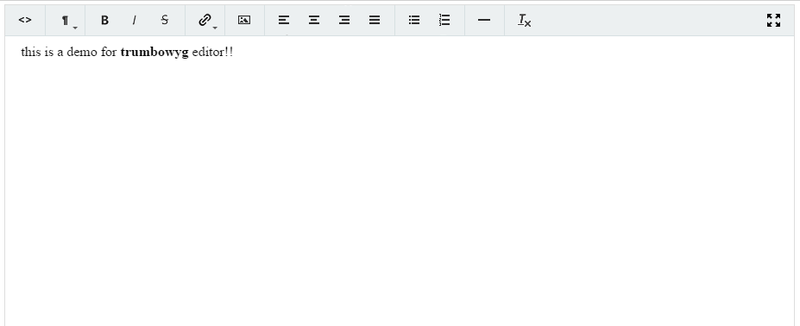Tbeditor"
Chunfuchang (talk | contribs) |
m ((via JWB)) |
||
| Line 39: | Line 39: | ||
=Supported Events= | =Supported Events= | ||
| − | {| | + | {| class='wikitable' | width="100%" |
! <center>Name</center> | ! <center>Name</center> | ||
! <center>Event Type</center> | ! <center>Event Type</center> | ||
| Line 61: | Line 61: | ||
=Use Cases= | =Use Cases= | ||
| − | {| | + | {| class='wikitable' | width="100%" |
! Version !! Description !! Example Location | ! Version !! Description !! Example Location | ||
|- | |- | ||
| Line 72: | Line 72: | ||
{{LastUpdated}} | {{LastUpdated}} | ||
| − | {| | + | {| class='wikitable' | width="100%" |
! Version !! Date !! Content | ! Version !! Date !! Content | ||
|- | |- | ||
Revision as of 13:11, 7 January 2022
Tbeditor
- Java API: N/A
- JavaScript API: N/A
Employment/Purpose
The component used to represent Trumbowyg
Tbeditor is a rich text editor to be used inside web pages. It's a WYSIWYG editor, which means that the text being edited on it looks as similar as possible to the results users have when publishing it.
Example
<tbeditor id="tb" value="this is a demo for <b>trumbowy</b> editor!!" />
Customized Properties
Tbeditor provides a way for users to customize their own properties, check official document for the detail[1]. Here shows a simple example how to programmatic change the property.
Map config = new HashMap();
config.put("btns", new JavaScriptValue("['bold', 'italic', '|', 'link']"));
config.put("closable", true);
tb.setConfig(config);
We create a map while key is property name with reasonable value. Note that we have to wrap the value into JavaScriptValue object if it's not String.
- ↑ Not support all properties, for example, localization, custom skin, are not supported.
Supported Events
| InputEvent
Description: Denotes the content of an input component has been modified by the user. | |
| InputEvent
Description: Denotes that user is changing the content of an input component. Notice that the component's content (at the server) won't be changed until onChange is received. Thus, you have to invoke the getValue method in the InputEvent class to retrieve the temporary value. |
Supported Children
*NONE
Use Cases
| Version | Description | Example Location |
|---|---|---|
Version History
| Version | Date | Content |
|---|---|---|
